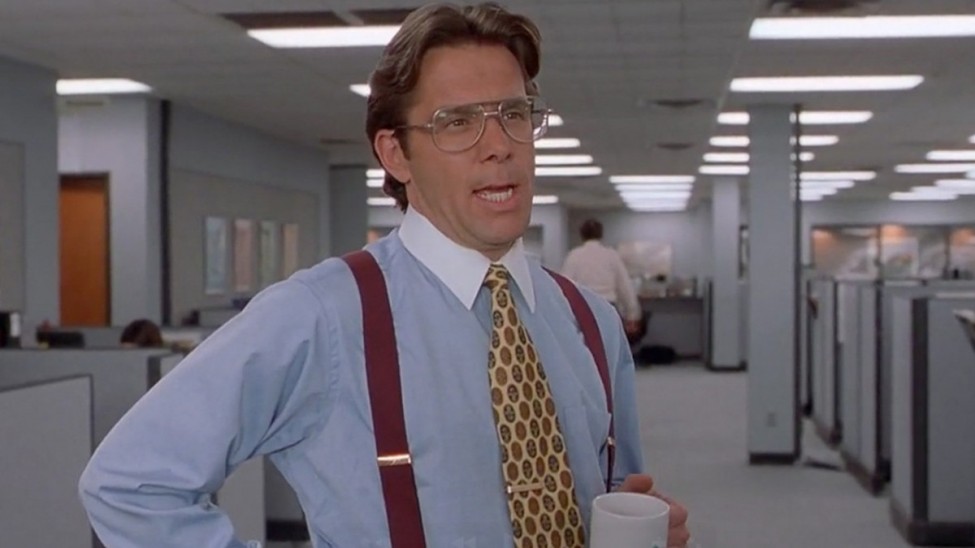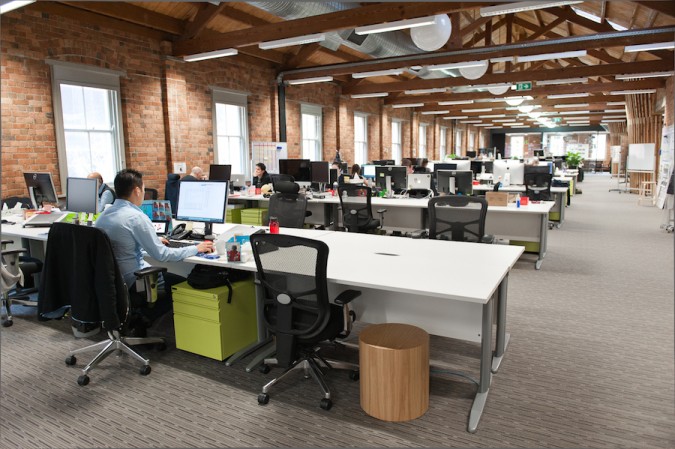
Once you’ve tasted the sweet nectar of remote work, you’ll never go back to the tyranny of an office job.
I was once enslaved by a cubicle. I put a lot of effort into decorating that cubicle, but not even my colorful travel photos could improve the scenery. Everything was beige. And beige with fluorescent lighting is not a good look. It was very Office Space-y.

Then one day the boss said, “I’m going to Asia for a week, you can work from home if you want.” Done and done. This was six years ago, and I haven’t worked for a company that doesn’t allow remote work since.
Hot Topic
A couple of years ago, Yahoo CEO Marissa Meyer made headlines after she changed Yahoo’s work-from-home policy to require all remote workers to return to the mothership. People weren’t thrilled. Especially since some say she was punishing everyone for a few bad apples. Meyer caught the bad apples by tracking VPN traffic and noting a low number of logins. Ruh-roh.
Fast forward to January 2015. I’m interviewing for this shiny new job at Rafflecopter when I’m offered the position and obviously accept. One of my first assignments was to read the book Remote: Office Not Required by the founders of 37 Signals (people behind Basecamp). I was already a believer in remote work so the book didn’t convince me of anything new, but the fact my new employer identified with the principles outlined in the book was a huge statement to the company’s culture. I knew I was at the right place.
Productivity
Have you experienced the rise of the open floor plan? The cube farm without walls? Executives tout the benefits of the supposed increased collaboration, but I’ve only ever heard rants about distractions, distractions, and more distractions. How are you supposed to be productive when you have someone lurking behind your shoulder waiting to talk to you, another person having a loud phone conversation, and who knows how many other visual distractions?

Source: InVision
”If you ask people where they go when they really need to get work done, very few will respond ‘the office.’” The authors of Remote make the point that meaningful work takes “stretches of uninterrupted time to get in the zone.” But that usually can’t be found in the office.
The New York Times hosted a debate earlier this year around open-office layouts vs. cubicles. Not only did most of the debaters argue against open layouts, a huge number of commenters shared their personal experiences with the setup. Hint: it wasn’t good. Most cited noise, lack of privacy, and colleague interruptions as the major detractors to their productivity.
At Rafflecopter, we have an open layout, but we also have a headphone culture. Among the offices I’ve been a part of, our office is the most conducive to productivity. It’s quiet, clean, and has the natural light Pinterest boards dream of. Yet sometimes I just can’t do it. I’ll try sitting at my desk, standing at my desk, sitting on the couch, sitting on the other couch, and still nothing. Sometimes I just need the dull roar of a coffee shop to get my head in the game.

Rafflecopter office
New scenery provides a fresh perspective, so when I’m feeling stuck, I relocate. Sometimes it’s to my house, other times it’s to a favorite coffee shop. I’ve nailed down which space works best for the task at hand.
The bottom line of any job is productivity. Remote puts it nicely, ”When you can’t see someone all day long, the only thing you have to evaluate is the work.” You’re not worried about when they got in, when they left, how many times they took a coffee break. You can only see the output.
Trust
One of the best lines in Remote: ”If you can’t let your employees work from home out of fear they’ll slack off without your supervision, you’re a babysitter, not a manager…The bottom line is that you shouldn’t hire people you don’t trust, or work for bosses who don’t trust you.”
Like all good relationships, a flourishing work environment is built on trust. Without it, you’re destined to underperform. You start worrying about being seen at certain times, what’s showing on your computer screen when the boss walks by, etc. Not the quality of work you’re producing. That’s stressful and demotivating. Instead, imagine a world where you can work when and where you’re productive.
Marisa Meyer’s announcement regarding telecommuting at Yahoo sparked a huge debate. Richard Branson wrote a post in response to her decision, “We like to give people the freedom to work where they want, safe in the knowledge that they have the drive and expertise to perform excellently, whether they’re at their desk or in their kitchen. Yours truly has never worked out of an office, and never will.”
If you’re not productive at your desk at 9am, why are you at your desk at 9am? Start work at 10 am at your kitchen table.
The New Luxury
”The new luxury is the luxury of freedom and time. Once you’ve had a taste of that life, no corner office or fancy chef will be able to drag you back.” Remote nailed it.
On days I work from home I save an hour of travel time and the stress of a commute. That’s an extra hour to work on a hobby, go for a hike, or run errands before the masses let out.
But it wouldn’t be a luxury without boundaries. Establishing an understanding with your employer and/or employees is crucial in making this a success. Just because I work from home doesn’t mean I’m available to work 24/7. I don’t want to be walking example of this Onion article. The authors of Remote are big supporters of the 40 hour work week and argue that not much gets done after 40 hours anyway.
Just as your employer needs to respect your personal boundaries, it’s necessary to set boundaries with roommates, family, and friends. Just because I’m at home doesn’t mean I can play.
Before negotiating a salary, confirming a remote policy would be my priority if I had to go on another job search. It’s worth more to me than the usual office perks, and I wouldn’t give it up without a fight.
In Boulder, it’s almost unheard of to find a tech company that doesn’t allow remote work. And when you do, it’s a cringe moment. You immediately start judging their company culture and leadership. Lack of a remote policy is a deal breaker for people around these parts.
How We Do It
Writing. During the hiring process at Rafflecopter, everyone is asked to complete a mini-project related to their potential position. My project was a writing assignment. Since this position involves communicating with customers and coworkers consistently, they wanted to make sure my writing skills weren’t a hot mess. Communication is key in a remote position.
Balance. Everyone at Rafflecopter makes an appearance in the office at some point in the week. Some people work from home in the mornings and come to the office in the afternoon, while others spend full days at home. We only have one face-to-face meeting throughout the week, and if someone is out, we video chat.
Right now Josh is working abroad. It’s been two months and nothing has changed as far as our team’s productivity or morale. We actually replaced his desk with a comfy chair, so it worked out in our favor ;)
Tools. Remote work wouldn’t be possible without some tech tools. Here’s what we use:
- Slack. For all things chatty. If we need an answer asap, Slack is where it’s at. This is also where we post our daily memes and gifs.
- GitHub. In-depth product discussions.
- Asana. This is how we track projects, progress, and more.
- Google Hangouts. When we forget what each other look like.
Conclusion
If you’re a boss, loosen the reigns and consider remote work for your team. If you’re an employee, forward this to your boss :)
“For all those sitting in traffic right now.” – Remote